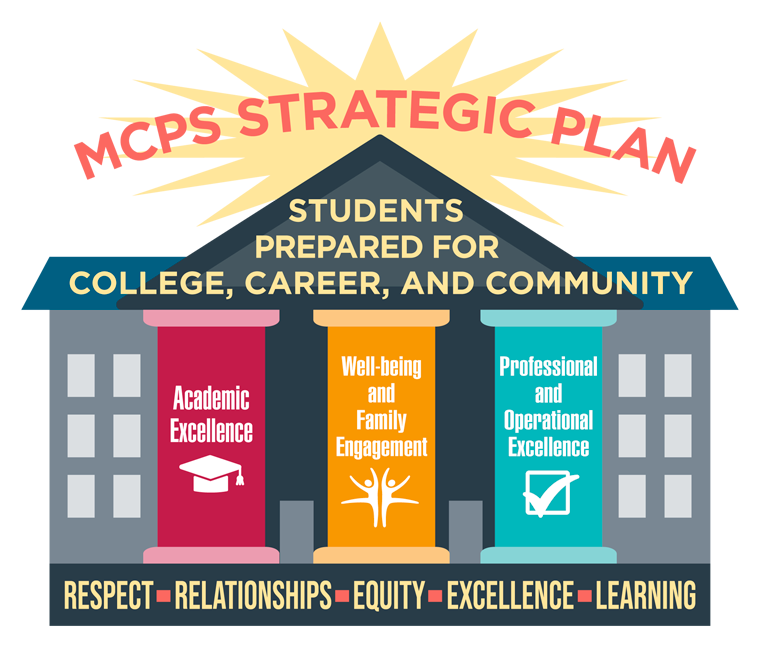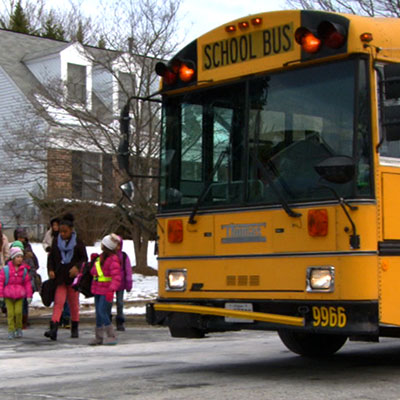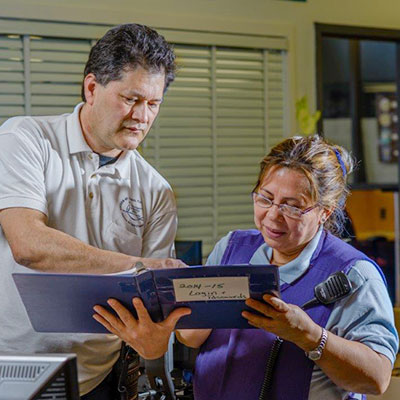Welcome to Budget 101!
Montgomery County Public Schools has a $3.32 billion operating budget for Fiscal Year 2025 to fund the operations of 211 schools and provide for the educational needs of our more than 160,000 students. We created Budget 101 to provide an overview of what's in the MCPS operating budget. This site will show you where our funding comes from, how it's spent, and how we staff individual schools to ensure we are meeting the needs of every student. Watch this short overview video to learn more...

The budget is the MCPS Strategic Plan in numbers.
The MCPS budget is driven by three factors that impact how and where we invest our resources.

Enrollment in MCPS has grown by 20,683 students in the past 14 years. The district receives additional dollars from the state and the county based on enrollment each year.



| Source | Amount | % |
|---|---|---|
| Local | $2,128.6M | 64.1% |
| State | $971.6M | 29.2% |
| Federal | $112.8M | 3.4% |
| Future Supported Projects/Other | $18.2M | 0.6% |
| Enterprise Fund | $91.1M | 2.7% |

Funding the MCPS budget is a partnership, with funding coming from three main sources:

Tax revenue and other county dollars provide the most revenue for the MCPS budget—about 64.1 percent.

Almost 30% of the budget (29.2%) is funded through state revenue. The percentage of the budget funded through state revenue has grown in recent years, due in part to the passage of the Blueprint for Maryland's Future legislation.

The federal government provides 3.4 percent of the money used to fund the MCPS budget. In FY 2025, this percentage has remained fairly constant in recent years.
Maintenance of Effort (MOE) is a state law established in 1984 that requires every local government to spend at least as much per student as it did the previous year to receive additional state aid for education. MOE funding typically is calculated for a school year by taking the official K-12 enrollment from the prior year and comparing it to the official K–12 enrollment from two prior years. The amount of enrollment change is multiplied by the cost per pupil for the previous year to determine the incremental funding change required under the MOE law.
For Fiscal Year 2025, Montgomery County Public Schools received $159.1 million in funding from the county more than the minimum funding level under the MOE law. This increase in funding for MOE was based on the student count as of September 30, 2023 for the 2023-2024 school year compared with the previous year. MOE is the minimum amount of funding the state requires the county to provide, but it is not sufficient to cover the increases in costs that MCPS—or any school system—incurs. For example, MOE doesn’t take into account basic cost increases for such things as utilities, textbooks, etc, in additional to the costs of staff compensation changes and new programs.
Why the minimum level of funding of funding under the MOE law does not provide sufficient resources for the FY 2025 budget.

Enrollment growth and the opening of additional space across the district and a new grade at Cabin Branch Elementary School require 56 positions and $4.0 million (excluding FY 2024 non-recurring costs) in FY 2025.

Inflation-related, rate changes, and other costs totaled
$22.2 million in FY 2024

Costs related to employee benefits had a cost increase of $40.0 million in FY 2025 for our Employee Benefits Plan.

Costs related to salary increases totaled $79.5 million in FY 2025 based on the second year of the two-year contracts with the employee associations approved in Spring 2023.
All combined, these additional requirements total $217.1 million in FY 2024.

The vast majority of the MCPS budget goes exactly where it should—into the classroom and to services that directly support student success. Education is a people business and that is why almost 90 percent of the MCPS budget pays for the salaries, wages, insurance, and benefits for the teachers, support professionals, and administrators who work with and on behalf of students every day.


The vast majority of our employees work in our 211 schools.
MCPS recently contracted with a professor at a local university to conduct a study to determine the economic impact that our school district has on Montgomery County and the State of Maryland. This study
can be found at the following link:
Study
In addition, we have prepared a one page summary of the conclusions of the economic impact study. The one page summary can be found at the following link:
Summary
A few of the highlights from the study include the following examples. First, excluding payroll, every dollar spent by MCPS generates $1.45 in economic activity in Montgomery County. Second, overall, MCPS generates $3.68 billion in economic activity in our county. Third, MCPS’ annual outlays support 37,400 jobs in Montgomery County. In fact, MCPS is the second largest employer in Montgomery County, with only the federal government being a larger employer than MCPS.
Like other employers, MCPS offers health benefits coverage to its current employees and retirees.
EBP is a mostly self-insured plan in that MCPS assumes the risk and liability to pay for the health benefits costs that are incurred by both employees and retirees.
EBP expenditures in FY 2024 are expected to total $625.0 million for active employees and retirees.*
EBP expenditures are funded from the MCPS Operating Budget, active and retired employee contributions and rebates.
Expenditures result from premiums paid to health care organizations, claims submitted by employees and retirees for health care services, and for administrative expenses.
*Based on actuarial projections as of October 2023.

As the vast majority of the MCPS operating budget pays for personnel and funds the instructional program in each school, a common question often asked concerns how schools are staffed. Specifically, how does MCPS decide how many teachers, administrators, and support professionals work in each school? How does MCPS determine which schools will be allocated additional staff to have lower class sizes compared to other schools? These and many other questions can be answered by reviewing the following materials.
MCPS funds its schools using four key principles:
Resources are allocated in an equitable, consistent manner in all 205 schools.
Schools that serve students with greater needs get greater resources.
The process gives building leaders the flexibility they need to use allocated resources to serve their students.
Everyone should understand the process and know how decisions are made in allocation of resources.

First, we allocate staff based on enrollment. It means that a school of 600 in Silver Spring gets the same base of staff as a school of 600 in Damascus or Rockville or Germantown. For instance, every school gets a principal. Every middle school gets an assistant principal, as well, but middle schools that have 650 or more students get a second assistant principal. In elementary schools, staffing for teachers is based on guidelines for class sizes. For Grades 1 through 3, schools are allocated teachers to keep class sizes at 27 or less. So, if a school has 100 first graders, it will receive four teachers. If enrollment increases to 120 first graders, the school will receive five teachers.

Next, we differentiate allocations based on the needs of the students the school serves. Schools that have more students who are economically disadvantaged receive extra staff to lower class sizes and provide additional support and interventions. For instance, in our higher-poverty elementary schools, we try to keep the average class size for Kindergarten and Grades 1 and 2 at 18 students or lower. So, based on enrollment, these schools get additional allocations. If a school has a higher population of English language learners, they will receive additional staff to provide English for Speakers of Other Languages (ESOL) services. However, the process provides flexibility to principals to allow them to address the specific needs of their school community.

MCPS also allocates staff and resources based on programs. If a school has a magnet, a special education center, or some other type of program, additional staff is provided. It’s important to note that special education staffing is allocated differently and is based on the needs outlined in each student’s Individualized Education Program (IEP).
Let’s look at the allocations for three actual elementary schools in MCPS, each with a similar enrollment but different numbers of students who receive English for Speakers of Other Languages (ESOL) services and/or free and reduced-price meals (FARMS), which is an indicator of poverty.



School A has a very low percentage of students receiving free and reduced-price meals—or FARMS. They also have very few ESOL students.
School B has a higher needs student population and School C would be among our most impacted elementary schools. Let’s look at their allocations.
School ALow FARMS(600, 6%, 37) |
School BFocus(615, 50%, 113) |
School CTitle I(609, 82%, 317) |
|
|---|---|---|---|
| Kindergarten | 4 | 6 | 6 |
| Classroom Teacher 1-5 | 21.6 | 24 | 24 |
| Nonteaching | 4 | 4 | 4.5 |
| AMPE (Art, Music, PE) | 3 | 3.9 | 3.9 |
| Clerical | 2.5 | 2.5 | 2.5 |
| Focus/AI | 0 | 2.7 | 5.8 |
| ESOL | .7 | 2 | 7.2 |
| Ed Assistant | 3.75 | 6 | 5.1775 |
| Total | 39.55 | 51.1 | 59.0775 |
As the chart demonstrates, schools with more needs receive additional staff to serve students. Since students who live in poverty generally come to school needing more help with reading, Schools B and C are provided Academic Intervention (AI) teachers to improve literacy and academic outcomes. School C also receives significantly more ESOL staff since it serves a greater number of English language learners.
View Your School's Staffing Levels
NOTE: The 2017–2018 Schools at a Glance report provides staffing for every school in MCPS last school year. However, it is important to note that staffing is slightly different from allocations. A school’s staffing reflects actual staff in the school at a particular time during the school year. This can be impacted by enrollment fluctuations, staff departures or long-term absences, and other factors.

There are many MCPS employees who directly serve students, but are not part of the staffing allocations that schools receive. Here are just a few examples:

MCPS transports over 102,000 students to and from school every day, with over 96,000 for regular education and over 6,000 for special education services. DOT provides school buses to neighborhood schools, Head Start, magnet, International Baccalaureate, language immersion, consortium, and other special programs. There are over 1,200 MCPS buses on the road each day servicing schools for these programs. In addition, there are over 14,000 supplemental transportation services provided on an annual basis for field trips and extracurricular activities for instructional programs. The number of miles our bus drivers travel each school day would circle the equator more than four times, or over 100,000 miles each day.

MCPS serves more than 16 million balanced, nutritious meals to students each year. More than 40 percent of MCPS students receive free or reduced-price meals, and the United States Department of Agriculture provides funding to offset some of the cost of providing student meals. The federal meal reimbursements do not cover the cost of the meals. Our meals programs are an "enterprise" account, meaning the revenue raised through meals is used to sustain and improve services.

A well-designed facilities maintenance program is a vital component of MCPS. Facilities and maintenance staff ensure clean and safe learning environments for students and school-based staff and by doing so they support optimal academic performance and achievement. MCPS has 211 schools that total more than 26 million square feet, including over 500 relocatable classrooms, and 24 support facilities.
The facilities and maintenance staff collaboratively provide general maintenance (HVAC, plumbing, carpentry, electrical, grounds care, and waste removal), repair of MCPS facilities and the equipment located therein, preventive maintenance of systems, training for site-based building services teams, and support for the operational needs of MCPS schools.
The current enrollment of more than 160,000 students is projected to continue to increase for the foreseeable future. The most relevant and impactful obstacle is funding. Budgetary constraints and other factors continue to impact the ability to meet the needs of all MCPS facilities in their current state. Temporary solutions avoid system failures, but temporary solutions are not designed to be permanent solutions. Facilities and maintenance staff will continue to ensure that students are learning in a clean, safe, and comfortable environment. Increased financial support would positively impact the ability to keep doing so.
To learn more about facilities and maintenance, take a look at the Comprehensive Maintenance Plan. Available Here.

Developing the MCPS budget is a year-round process that involves many stakeholders and input from students, staff, and community members.
Ensuring our work is aligned to our needs and our strategic goals
Working with elected officials, community, staff and parents to develop a budget for MCPS
Allocating resources in an equitable, transparent manner
Providing schools with the staff they need to serve their students
Ensuring we are getting a return on the investment that our community makes
We don’t create the MCPS budget in a bubble—we work with many stakeholders and partners to create a spending plan that reflects our values and priorities.
The Board of Education adopts its operating budget request for MCPS at a February meeting each year. This is after holding public hearings to receive input from the community and meetings with MCPS staff to review the details of the budget request. These hearings and meetings take place in January. Final approval of the operating budget occurs at a meeting in June.
Our employees and our parents are an important part of the budget process. In fact, representatives from our employee associations, the Montgomery County Council of PTAs, Latino Student Achievement Action Group, and the African American Student Achievement Action Group serve on the budget committee that reviews office and department budgets and helps the superintendent build a recommendation.
The voices of students, parents, staff, and community members are an important part of the budget process through public hearings, written input, and other engagement opportunities. Each year, the Board uses this input to ask questions about and make changes to the superintendent’s recommendation. These questions are archived here.
Throughout the budget process, we work closely with the Montgomery County Executive and County Council on a budget that meets the needs of the school system. We recognize that our county lead text-centerers have many priorities, but we also know they recognize the importance of MCPS in securing a bright future for Montgomery County.
Developing and implementing the budget is a year-round process.
For more information please visit:
View the FY 2024 Operating Budget